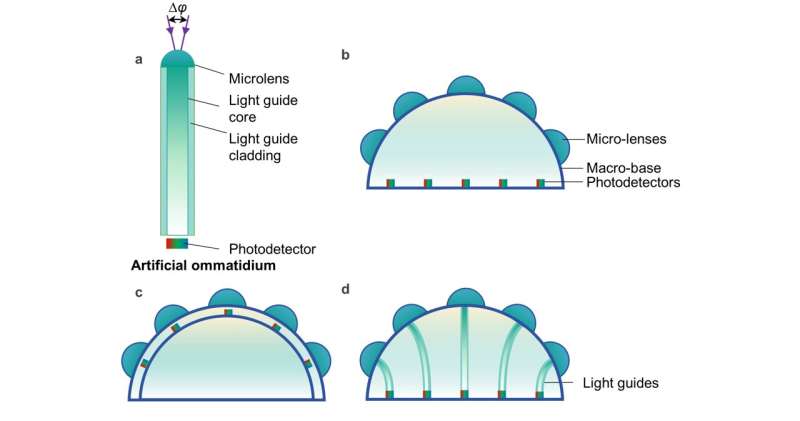This article has been reviewed according to Science X's editorial process and policies. Editors have highlighted the following attributes while ensuring the content's credibility:
fact-checked
proofread
Exploring biomimetic curved artificial compound eyes

As one of the most successful eye designs in the animal kingdom, natural compound eyes (NCEs) have attracted significant research attention in replicating the anatomical configuration to form biomimetic curved artificial compound eyes (BCACEs).
In this review, Professor Xuming Zhang's group from The Hong Kong Polytechnic University starts with a simple classification of NCEs and then provides a comprehensive review of the main parameters, operational mechanisms, recent advancements, fabrication methodologies, and potential applications of BCACEs.
This work is distinctive since the authors focus especially on the "curved" ones, which are difficult to fabricate but closely resemble the architecture and functions of NCEs and could potentially revolutionize the imaging systems in surveillance, machine vision, and unmanned vehicles.
Importantly, For BCACEs, the further emulation of natural compound eyes and combination with optofluidic tunable lenses are discussed to present a promising avenue for providing better instruments and devices.
The highlights of this review are as follows:
- The authors propose several parameters for evaluating biomimetic curved artificial compound eyes (BCACEs), including the field of view, acceptance angle of each ommatidium, inter-ommatidial angle, quantitative imaging performance metric, optical sensitivity, and highest angular perception speed.
- Based on the operational mechanisms, BCACEs are clarified. Specifically, they are divided into those with fixed focal lengths and those with tunable focal lengths, with further subcategorization within each type.
- Various fabrication methods for BCACEs are introduced, such as planar lens array deformation and laser direct writing.
- Applications of BCACEs are showcased, including dynamic monitoring.
- Brief discussions on the future development of BCACEs are demonstrated, including the further emulation of natural compound eyes and combination with optofluidic tunable lenses.
This paper has provided a comprehensive review of biomimetic curved artificial compound eyes (BCACEs). Rooted in the foundational underpinnings of natural compound eyes (NCEs) and BCACEs, the authors have introduced a set of parameters to delineate the characteristics of BCACEs. The reviewed BCACEs are categorized into two primary types based on their working principles: those with fixed focal lengths and those with tunable focal lengths.
In particular, the former type can be further subdivided into three categories, namely, simplified BCACEs, BCACEs with photodetector arrays within curved surfaces, and BCACEs with light guides. The latter type can also be categorized based on various techniques for altering the shapes of micro-lenses, including fluidic pressure, thermal effects, and pH adjustments.
Concerning fabrication, while some innovative methods, such as laser direct writing, have been proposed for creating curved micro-lens arrays used in BCACEs, the production of a complete BCACE system that can rival the performance of sophisticated NCEs remains an exceedingly challenging task.
Consequently, BCACEs still have a considerable journey ahead. For instance, novel design concepts and fabrication approaches need to be developed to emulate not only apposition NCEs but also optic superposition NCEs and neural superposition NCEs. Furthermore, the integration of BCACEs with optofluidic tunable lenses enables precise control over light manipulation, thereby facilitating the realization of artificial intelligence systems with enhanced information processing capabilities.
In summary, it is foreseeable that BCACEs will transform micro-optical imaging systems into versatile platforms for practical applications, including but not limited to smart health care, intelligent robotic vision systems, and unmanned aerial vehicle vision systems.
The work is published in the journal Advanced Devices & Instrumentation.
More information: Heng Jiang et al, Biomimetic Curved Artificial Compound Eyes: A Review, Advanced Devices & Instrumentation (2024). DOI: 10.34133/adi.0034




















